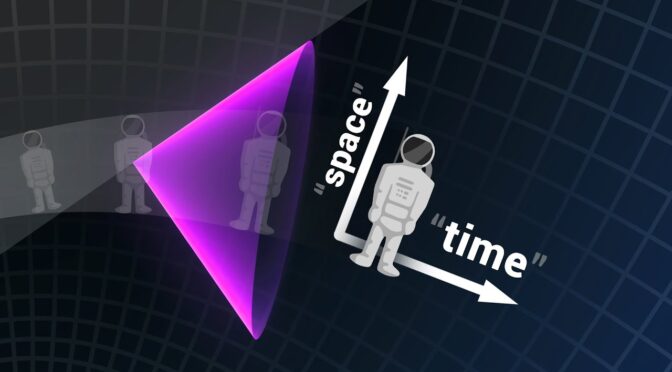This article is based on the video titled “Why Time and Space swap in a Black Hole” by ScienceClic English. The video delves into the perplexing phenomena of black holes, where the conventional understanding of time and space undergoes a radical transformation. It employs the concept of light cones to elucidate how time and space are fundamentally different yet interconnected, and how their roles astonishingly switch when in the vicinity of a black hole.
Contents
- The Role of Light Cones in Understanding the Universe
- Time and Space
- General Relativity and the Curvature of Space-Time
- The Anatomy of a Black Hole
- The Distant Observer and the Falling Astronaut
- Penrose Diagram
- The video
The Role of Light Cones in Understanding the Universe
Light cones serve as a visual representation to understand the limitations imposed by the speed of light on the universe (think of them as boundaries we cannot cross). When a candle emits light, it forms a growing bubble of light that represents the light cone. The trajectory of any object within this light cone is constrained by the speed of light, making it impossible to escape. This concept is crucial in understanding cause-and-effect relationships in the universe, as no event can affect another until its light cone intersects with the other’s position.
Time and Space
The video makes a compelling argument about the inherent difference between time and space. While space allows for movement in any direction, time is a one-way street, always moving from the past to the future. Light cones visually represent this difference: they force us to move in a specific direction in time, while in space, we have the freedom to choose any direction. This distinction is vital for understanding the nature of the universe and how we interact with it (it’s like being on a train that only goes forward, with no way to turn back).
General Relativity and the Curvature of Space-Time
When a massive object like Earth is introduced into the equation, the light cones start to bend due to the object’s gravitational pull. This bending signifies that time itself is being distorted towards the center of the massive object. General relativity explains this phenomenon by stating that mass warps the geometry of space-time, making time and space relative and dependent on one’s position in the universe.
The Anatomy of a Black Hole
A black hole is essentially a region where the curvature of space-time is so intense that all light cones point towards its center. This makes it impossible for anything, even light, to escape its gravitational pull. The boundary of this region is known as the horizon, and once an object crosses it, its future is inevitably directed towards the center of the black hole. This is where the roles of time and space intriguingly switch, making the center of the black hole not just a point in space but an event in our future that we cannot avoid.
The Distant Observer and the Falling Astronaut
The video also discusses the experiences of a distant observer and a falling astronaut to provide a comprehensive understanding of a black hole. For the distant observer, the black hole appears stationary, and time flows normally. For the falling astronaut, as she approaches and eventually crosses the horizon, time and space start to tilt, making it impossible to escape the gravitational pull of the black hole (imagine being sucked into a vortex where all paths lead to the center).
Penrose Diagram
Lastly, the video introduces the Penrose diagram, a compactified representation that clearly demarcates the inside and outside of a black hole. Once an object crosses the horizon, it can no longer interact with the rest of the universe; its only possible future is to move towards the singularity at the center of the black hole.
The video offers a comprehensive yet accessible explanation of these complex phenomena, making it an invaluable resource for anyone interested in understanding the enigmatic nature of black holes and the universe.

